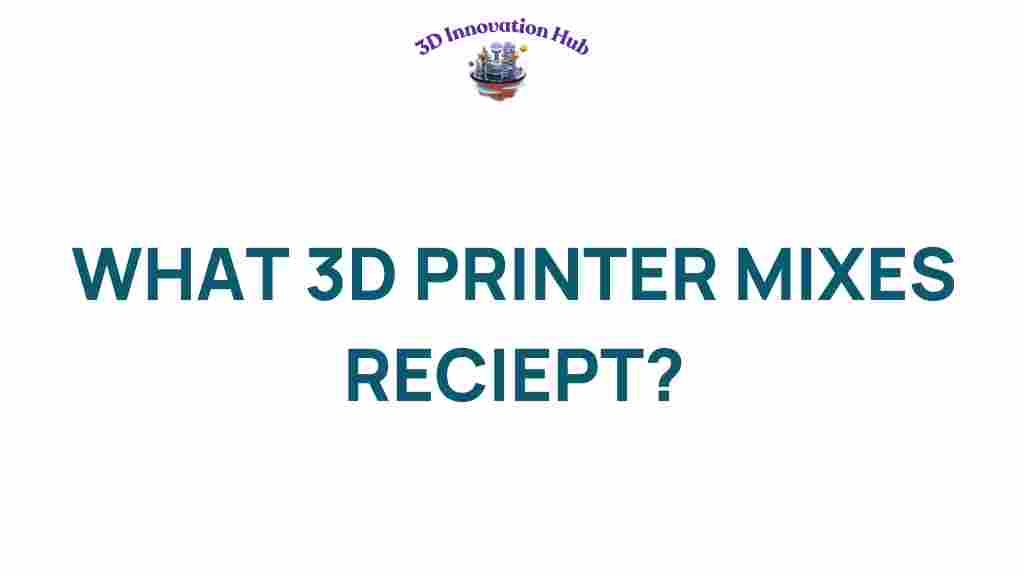Unveiling the Future: What 3D Printer Mixes Recipes for Culinary Innovation?
The culinary world is experiencing a revolution thanks to advancements in food technology, particularly with the advent of the 3D printer. The intersection of gastronomy and technology has given rise to a new wave of creativity in the kitchen. By utilizing additive manufacturing, chefs and home cooks alike can explore the boundaries of what is possible in food preparation and presentation. This article dives into the fascinating realm of recipe printing, showcasing how a 3D printer can mix recipes to enhance culinary innovation.
Understanding 3D Printing in the Culinary World
3D printing in the culinary sector involves using a 3D printer to create food items layer by layer. This process allows for precise control over the shapes, textures, and flavors of the food being created. Unlike traditional cooking methods, which require mixing and cooking ingredients separately, recipe printing streamlines this process using digital cooking techniques.
The Benefits of Culinary Innovation with 3D Printing
- Customization: Create personalized meals tailored to dietary needs and preferences.
- Creativity: Experiment with complex designs and combinations that would be difficult to achieve by hand.
- Efficiency: Reduce food waste by printing exactly what you need.
- Presentation: Produce eye-catching dishes that are sure to impress guests.
How to Get Started with a 3D Printer for Recipe Printing
Starting your journey in culinary innovation with a 3D printer involves several steps. Here’s a straightforward guide to help you dive into the world of recipe printing.
Step 1: Choose the Right 3D Printer
When selecting a 3D printer for food, consider the following features:
- Food Compatibility: Ensure the printer can handle edible materials.
- Print Size: Choose a printer with a build volume suitable for your culinary creations.
- Ease of Use: Look for user-friendly software and controls.
Step 2: Select Your Ingredients
Common materials used in food 3D printing include:
- Puree: Vegetables, fruits, and sauces can be easily printed.
- Chocolate: Melted chocolate is a popular choice for intricate designs.
- Dough: Use bread or pastry dough for savory creations.
Step 3: Design Your Recipe
Using software for digital cooking, you can create or select recipes to print. There are many design tools available that allow you to visualize your recipe in 3D. You can also download pre-made designs from online repositories.
Step 4: Print Your Recipe
Once your design is ready and your ingredients are prepared, it’s time to print. Follow these steps:
- Load the ingredients into the printer.
- Set the temperature and speed according to the type of material.
- Start the printing process and monitor it to ensure everything is running smoothly.
Step 5: Finish and Serve
After printing, some items may require additional cooking or assembly. Make sure to follow any finishing steps outlined in your recipe. Once ready, present your creation beautifully to enhance the dining experience!
Troubleshooting Common Issues with 3D Food Printing
Like any kitchen gadget, a 3D printer may encounter some hiccups. Here are some common issues and how to troubleshoot them:
Problem 1: Clogging
If your printer nozzle clogs, try these steps:
- Use a cleaning tool to remove any blockages in the nozzle.
- Ensure your ingredients are blended smoothly before printing.
Problem 2: Poor Print Quality
For prints that don’t look as expected, consider the following:
- Check the thickness of the material; it may need to be adjusted.
- Examine the printer settings to ensure proper speed and temperature are set.
Problem 3: Inconsistent Layering
If layers are not adhering properly, try these solutions:
- Ensure the printer bed is level and clean.
- Adjust the extrusion speed to allow better adhesion between layers.
Innovative Uses of 3D Printing in Gastronomy
The possibilities for culinary innovation with a 3D printer extend beyond just printing recipes. Here are some innovative uses:
- Custom Chocolate Shapes: Design unique chocolate treats for events.
- Personalized Nutrition: Print meals tailored to specific dietary requirements.
- Textured Foods: Create complex textures that enhance the eating experience.
Conclusion: The Future of Culinary Innovation
As we continue to explore the integration of technology in our kitchens, the potential of a 3D printer in culinary innovation is boundless. From recipe printing to creating entirely new food experiences, the combination of food technology and gastronomy is reshaping how we think about cooking and dining.
For those passionate about food and technology, investing in a 3D printer could open doors to endless creativity. Whether you are a professional chef or a home cook, the integration of additive manufacturing into your culinary practices can enhance your cooking capabilities and delight your guests. Embrace the future of digital cooking and let your imagination take the lead!
For further reading on the impact of technology in food, check out this resource. To discover various kitchen gadgets that complement your 3D printing adventures, visit this page.
This article is in the category and created by 3D Innovation Hub Team
